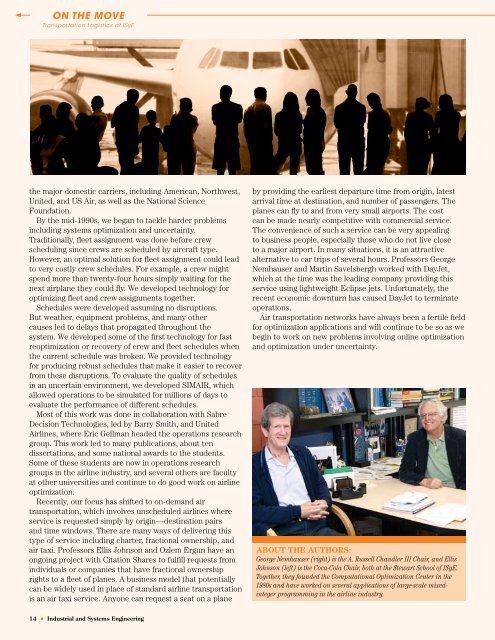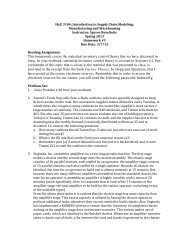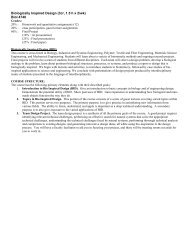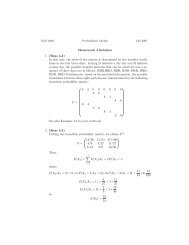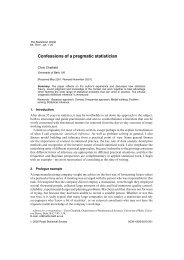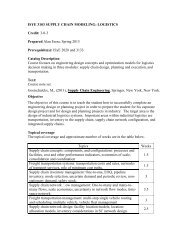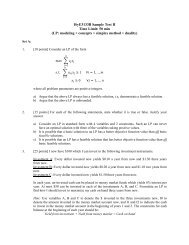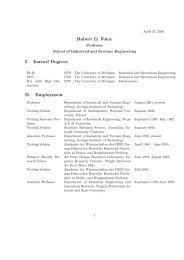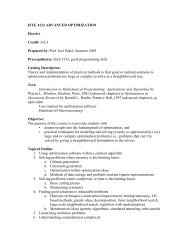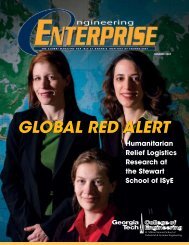Fall 2009 - H. Milton Stewart School of Industrial & Systems ...
Fall 2009 - H. Milton Stewart School of Industrial & Systems ...
Fall 2009 - H. Milton Stewart School of Industrial & Systems ...
You also want an ePaper? Increase the reach of your titles
YUMPU automatically turns print PDFs into web optimized ePapers that Google loves.
ON THE MOVE<br />
Transportation Logistics at ISyE<br />
the major domestic carriers, including American, Northwest,<br />
United, and US Air, as well as the National Science<br />
Foundation.<br />
By the mid-1990s, we began to tackle harder problems<br />
including systems optimization and uncertainty.<br />
Traditionally, fleet assignment was done before crew<br />
scheduling since crews are scheduled by aircraft type.<br />
However, an optimal solution for fleet assignment could lead<br />
to very costly crew schedules. For example, a crew might<br />
spend more than twenty-four hours simply waiting for the<br />
next airplane they could fly. We developed technology for<br />
optimizing fleet and crew assignments together.<br />
Schedules were developed assuming no disruptions.<br />
But weather, equipment problems, and many other<br />
causes led to delays that propagated throughout the<br />
system. We developed some <strong>of</strong> the first technology for fast<br />
reoptimization or recovery <strong>of</strong> crew and fleet schedules when<br />
the current schedule was broken. We provided technology<br />
for producing robust schedules that make it easier to recover<br />
from these disruptions. To evaluate the quality <strong>of</strong> schedules<br />
in an uncertain environment, we developed SIMAIR, which<br />
allowed operations to be simulated for millions <strong>of</strong> days to<br />
evaluate the performance <strong>of</strong> different schedules.<br />
Most <strong>of</strong> this work was done in collaboration with Sabre<br />
Decision Technologies, led by Barry Smith, and United<br />
Airlines, where Eric Gellman headed the operations research<br />
group. This work led to many publications, about ten<br />
dissertations, and some national awards to the students.<br />
Some <strong>of</strong> these students are now in operations research<br />
groups in the airline industry, and several others are faculty<br />
at other universities and continue to do good work on airline<br />
optimization.<br />
Recently, our focus has shifted to on-demand air<br />
transportation, which involves unscheduled airlines where<br />
service is requested simply by origin—destination pairs<br />
and time windows. There are many ways <strong>of</strong> delivering this<br />
type <strong>of</strong> service including charter, fractional ownership, and<br />
air taxi. Pr<strong>of</strong>essors Ellis Johnson and Ozlem Ergun have an<br />
ongoing project with Citation Shares to fulfill requests from<br />
individuals or companies that have fractional ownership<br />
rights to a fleet <strong>of</strong> planes. A business model that potentially<br />
can be widely used in place <strong>of</strong> standard airline transportation<br />
is an air taxi service. Anyone can request a seat on a plane<br />
by providing the earliest departure time from origin, latest<br />
arrival time at destination, and number <strong>of</strong> passengers. The<br />
planes can fly to and from very small airports. The cost<br />
can be made nearly competitive with commercial service.<br />
The convenience <strong>of</strong> such a service can be very appealing<br />
to business people, especially those who do not live close<br />
to a major airport. In many situations, it is an attractive<br />
alternative to car trips <strong>of</strong> several hours. Pr<strong>of</strong>essors George<br />
Nemhauser and Martin Savelsbergh worked with DayJet,<br />
which at the time was the leading company providing this<br />
service using lightweight Eclipse jets. Unfortunately, the<br />
recent economic downturn has caused DayJet to terminate<br />
operations.<br />
Air transportation networks have always been a fertile field<br />
for optimization applications and will continue to be so as we<br />
begin to work on new problems involving online optimization<br />
and optimization under uncertainty.<br />
ABOUT THE AUTHORS:<br />
George Nemhauser (right) is the A. Russell Chandler III Chair, and Ellis<br />
Johnson (left) is the Coca-Cola Chair, both at the <strong>Stewart</strong> <strong>School</strong> <strong>of</strong> ISyE.<br />
Together, they founded the Computational Optimization Center in the<br />
1980s and have worked on several applications <strong>of</strong> large-scale mixedinteger<br />
programming in the airline industry.<br />
14 • <strong>Industrial</strong> and <strong>Systems</strong> Engineering


